The Thanksgiving holiday is one of America's finest cultural traditions. And this year, patriots, you will all have one more thing to be thankful for.
'Merica Labz Red White & Boom – 2023 Update, with even more on Jan 6, 2024!
The legendary 'Merica Labz Red White & Boom pre-workout has received a "facelift" (to put it lightly), and you will not believe these labels. We're not just talking about the ingredient panels, either: The front labeling and branding is simply out of this world, with different artwork on each one, yet with all labels combining to create a monstrously insane canvas shown below:

This canvas encompasses the fronts of the tubs of the new Red, White, & Boom labeling. "Epic" doesn't even begin to describe it!
It also comes with the brand's new slogan, Can't Cancel Patriotism.
New formula, new labels, new flavors!
Comparing labels from the previous version updated in 2021, this new version is differentiated from the old by three little, but important, tweaks:

BOOM! The new Merica Labz Red White & Boom formula is out, with insane new artwork and the new slogan, "Can't Cancel Patriotism"
- L-citrulline has been replaced as the main pump and nitric oxide boosting ingredient by 3DPUMP Breakthrough, which contains citrulline in addition to glycerol and amla fruit extract. This is a great change – 3DPUMP Breakthrough is significantly more effective than ordinary citrulline!
- Arginine nitrate has been added for extra NO support and synergistic effects with the citrulline in 3DPUMP Breakthrough
- VasoDrive-AP has been removed.
And yes, it still has 420 milligrams total caffeine!
While we love VasoDrive-AP, the net effect of these three changes is undoubtedly to increase the pump you'll get from 'Merica Labz Red White & Boom. And if this epic formula doesn't have you convinced, the phenomenal label artwork will.
Finally, on January 6th, 2024, we got the latest installment added -- can you guess which flavor that is?!
Let's get into how it works, but first, check the PricePlow news and deals (the new flavors launched Black Friday 2023 are highlighted in yellow):
Merica Labz Red, White & Boom – Deals and Price Drop Alerts
Get Price Alerts
No spam, no scams.
Disclosure: PricePlow relies on pricing from stores with which we have a business relationship. We work hard to keep pricing current, but you may find a better offer.
Posts are sponsored in part by the retailers and/or brands listed on this page.
This area is reserved for Team PricePlow's upcoming Product Update video.
Subscribe to our channel and sign up for notifications so you catch it when it goes live!
2023 Red, White, & Boom Ingredients
In a single 1 scoop (22.5 gram) serving of Red White & Boom from 'Merica Labz, you get the following:
-
3DPUMP Breakthrough [L-Citrulline (Vegan Fermented) (3000 mg), Glycerol, Amla (Phyllanthus emblica) Fruit Extract] – 6,000 mg
3DPump-Breakthrough is a patented[1] blend of ingredients from NutraShure. It's designed to maximize the pumps you get during your workout, via several mechanisms of action. We also consider 3DPump-Breakthrough an ergogenic aid.
Here's what's in it:
- 3 grams of L-citrulline, a potent nitric oxide (NO) booster.[2] It improves circulation through NO-mediated vasodilation, which can improve athletic performance[3,4] and recovery.[5]
- 1.2 grams of glycerol, an osmolyte that forces water into your cells and causes cellular hyperhydration,[6,7] a state that's associated with better endurance.[6]
- 165 milligrams of amla fruit extract, a traditional Ayurvedic remedy for cardiovascular problems.[7] It's loaded with antioxidants that enhance endothelial function and reduces clotting.[8] Amla is high in low-molecular-weight tannins (LMWTs)[9] that are precursors to urolithins.[10] We like urolithins because of their beneficial impact on mitochondrial function,[11] a mechanism that can improve both health and performance.[12,13] Urolithin B, in particular, seems to have anabolic effects.[14]
Two studies showing actual pumps!
Nitric oxide is cool, but at the end of the day, it's a mechanism. We're interested in seeing the results of activating that mechanism – whether amla causes pumps. Notably, we have two excellent studies showing that it does.
The 3DPump Patent Pilot study
In the first of these studies, which is referenced in the 3DPump-Breakthrough patent, resistance-trained men, with an average age of 28 years old, participated in a crossover study. (Crossover means the same people are in the experimental and control groups.) Each volunteer completed four identical exercise sessions on different days, with a washout period between the workouts.[1]
The study participants took one of four treatments before each workout:
- Water
- 1,500 milligrams of glycerol
- 150 milligrams of amla fruit extract
- A combination of treatments 2 and 3
The exercise sessions included three sets of leg extensions and weighted goblet squats, at 10-12 reps per set, with one minute of rest between each set and two minutes of rest between exercises.
Immediately after each session, the researchers measured every subject's thigh circumference using a DEXA scanner. The rationale is that thigh circumference is determined, in part, by the water concentration in thigh tissue – the better the pump, the better hydrated the thigh, and thus, the bigger the circumference should be.
All four treatment conditions caused some post-workout thigh swelling and rise in lean body mass. The combination of glycerol and amla led to the biggest increase: 2.21 centimeters of extra thigh circumference and 700 grams of additional lean body mass. Compare this to the placebo, which caused only a 1.12 centimeter and 30 gram boost.[1]
Put simply, glycerol + amla caused 2x the thigh swelling and added 23x more lean mass than the placebo.
Peer-reviewed study – 6 grams 3DPump vs. 8 grams of citrulline
The May 2023 issue of the Journal of Exercise and Nutrition included a study that pitted 6 grams of 3DPump-Breakthrough against 8 grams of citrulline.[15] One really notable aspect of this study design is that citrulline is the current gold standard when it comes to boosting NO and pumps – so, if a smaller dose of 3DPump is competitive with a bigger dose of citrulline, that's very much to 3DPump's credit.
A new study has been published comparing 6 grams of 3DPump-Breakthrough against 8 grams of L-Citrulline! We dig into the details here on the PricePlow Blog.
This study actually got its own post on the PricePlow Blog, which you can read in our article titled "3DPump Breakthrough STUDY: 6g Takes on 8g L-Citrulline!"
But if you just want the highlights, here they are:
- Subjects: 22 men, 6 women, mean age of 29, recreational weightlifters
- Study type: single-blinded, crossover trial
- Methods: two different exercise sessions, one after each treatment condition, with a washout period in between. The workouts consisted of a treadmill warmup, followed by leg extensions, Smith machine squats, dumbbell arm curls, and tricep rope extensions.
- Data: arm and leg circumference immediately after exercise sessions, in addition to blood and urine samples collected before and after training (as well as 24 hours post-workout), analyzed for various biomarkers
The researchers found that the smaller dose of 3DPump had the same effect on limb circumference as the bigger dose of citrulline! This means that, gram-for-gram, 3DPump-Breakthrough appears to be a more effective pump booster than citrulline!
The study also found that the subjects' perception of their own muscle pumps, energy levels, and focus were a tie; as were their number of repetitions to failure and ability to recover after the workouts.[15]
However, the 6 grams of 3DPump actually performed better than the 8 grams of citrulline, particularly when it came to extracellular fluid and total body water increases,[15] which, probably, is thanks to its glycerol component.
It also outperformed citrulline at enhancing cardiovascular function,[15] and was better tolerated.[15]
-
Creatine Monohydrate – 5,000 mg
There are probably more peer-reviewed articles on creatine than any other supplement in sports nutrition, and this veritable mountain of evidence points overwhelmingly to one inescapable conclusion: creatine is awesome.
Creatine is both safe and effective, and it works to improve performance, recovery, and muscle growth by helping cells create adenosine triphosphate (ATP),[16-20] the energy currency they use to perform all metabolic tasks.
Because of its ability to increase cellular energy availability, creatine can improve:
- Power output[21,22]
- Lean mass gains[22-27]
- Sprinting speed[28-30]
- Hydration[31]
- Energy levels[32-35]
- Feelings of well-being[36-39]
- Cognition (in persons eating a plant-based diet)[40,41]
- Serum testosterone[42-46]
- Bone density[47]
Impressive list, right? Again, this is just the tip of the iceberg when it comes to the evidentiary support for creatine supplementation, which consists of hundreds of peer-reviewed studies. At the time of this writing, the search term "creatine monohydrate" on PubMed yields 540 results – and, as any veteran supplement researcher can tell you, there's also plenty of good research that's not listed on PubMed.
-
Beta-Alanine – 3,200 mg
Get ready to put fatigue down — here we have a full clinical daily dose of beta-alanine, the ingredient that combines with the essential amino acid L-Histidine to form carnosine. That's important because carnosine helps flush lactic acid from tiring muscles.
There have been two major meta analyses on beta-alanine across a huge series of sports and training types, and they confirm that beta-alanine boosts endurance.[48,49] This is especially true for exercises that are a bit longer-lasting than sprints — mostly those in the 30-second to 10-minute range.
As for those tingles, don't be alarmed – the sensation is known as paresthesia but beta-alanine has been shown to be safe and non-toxic.[50]
In this case, if you can't handle the full 420 milligrams of caffeine in the Boom pre-workout and choose to under-dose, consider adding a bit more beta-alanine somewhere else because 3.2 grams per day is what we shoot for to keep up with research-validated doses.
-
Arginine Nitrate (as NO3-T) – 1,000 mg
Although arginine supplementation has fallen out of favor in recent years, thanks to arginine's low oral bioavailability, there's a special case where it still makes sense – when it's taken in combination with citrulline. Since we're getting a pretty big dose of citrulline from the 6 grams of 3DPump-Breakthrough in 'Merica Labz Red, White & Boom, the addition of arginine is a good call.
Studies show that citrulline and arginine have synergistic effects, meaning the combination outperforms either ingredient taken alone.[51-53]
The mechanism here is citrulline's ability to inhibit arginase, the enzyme that ordinarily breaks down arginine in the stomach before it can be absorbed into the bloodstream by the intestines.[54,55] By enabling arginine to transit the gut intact, citrulline effectively increases arginine's oral bioavailability.
But arginine is only one half of the NO3-T molecule – the other half is nitrates.
We want nitrates for the same reason we want citrulline and arginine – nitrates help increase vasodilation by upregulating NO production. Nitrates do this by stimulating salivary glands, which are responsible for "fixing" nitrates into the NO molecule.[56-58]
Thanks to improved circulation via increased NO-mediated vasodilation, nitrate supplementation can improve:
- Circulation[59]
- Aerobic efficiency[59-62]
- Strength[63,64]
- Cellular energy production[64-66]
-
L-Tyrosine – 1,000 mg
L-Tyrosine is by far the best form of tyrosine supplementation. Tyrosine is the building block of our favorite neurotransmitters, including dopamine and norepinephrine. Taking more tyrosine, therefore, will lead to higher levels of these two alert-mode powerhouses.[67] Higher levels of these catecholamines will then give you better focus and lower your stress and anxiety levels.
Want even more heat though? Check out Merica Labz NAPALM Red White & Boom
Think of tyrosine as an "on-switch" to the sympathetic nervous system. The sympathetic system, better known as the body's "fight or flight" system, uses norepinephrine to trigger "fight mode" – and it's exactly what we need for the next revolution!
Sleep deprivation support!
Since we last wrote about this pre-workout, we've started digging into how well L-tyrosine supports sleep deprived individuals.[68,69] While we always suggest getting good night's sleep, bad sleep does occur, and L-tyrosine really seems to improve function for those in the sleep-deprived setting, especially next to caffeine.
The previous version of Boom Pre-Workout had a larger tyrosine dose, but it's been lowered to make room for extra adaptogenic power in the next ingredient, ashwagandha.
-
KSM-66 Ashwagandha Extract (Withania somnifera) (Root) (std. 5% withanolides) – 600 mg
Ashwagandha is an adaptogen, meaning it can help normalize biological processes.
More specifically, when your cortisol is too low, ashwagandha can raise it; and when it's too high, ashwagandha can lower it.[70,71] By helping keep cortisol levels in the appropriate range, ashwagandha can increase testosterone,[72] improve fertility,[73] enhance athletic performance,[72] encourage lean body composition,[74] and fight fatigue.[75]
Anecdotally, a generous dose of ashwagandha seems to take the edge off stims, which is great for 'Merica Labz Red, White & Boom since this formula contains over 400 milligrams of caffeine. Don't get us wrong, though – that's still a lot of caffeine, and your personal tolerance matters more.
-
Caffeine Anhydrous – 350 mg (of 420 mg total caffeine)
'Merica Labz is definitely going for the title of "1 scoop wonder" with the dosages present in Red, White, and BOOM. With 420 milligrams of caffeine per scoop, we recommend that you stick to a max of one scoop per day. But more importantly, we suggest starting with a half scoop so you can assess your tolerance levels, as mentioned numerous times above.
By inhibiting adenosine and phosphodiesterase,[76] this dose will wake your ass up. But even better, at the combined total dose in Red, White & Boom, it may even increase your power![77,78] That's right, certain individuals get strength gains at this dose, but it often depends on size (5-6 mg caffeine per kg of body weight is where gains occurred – this means individuals between 150-185 lbs or so, if full-scooping it).
What's interesting is that the second form of caffeine is extended release, so it won't hit at once — but most of it (350 milligrams here) will come first.
Note: Between caffeine anhydrous and zumXR, 'Merica Labz Red, White & Boom contains 420 milligrams total caffeine. That's a lot. If you aren't sure whether it's too much for you, ask your doctor.
-
Alpha-GPC 50% (L-Alpha glycerylphosphorylcholine) – 300 mg
Alpha-GPC is a high-quality source of choline, which is a building block for the acetylcholine neurotransmitter involved in a huge amount of functions the body relies on for athletic endeavors. By supplementing choline, you increase available acetylcholine levels. Since acetylcholine is associated with both learning and muscle contractions, you can expect enhanced focus and muscle output from this dose.[79,80] We'll also prolong this bump of choline with huperzine A at the bottom of the label.
Alpha-GPC and tyrosine team up for our nootropic stack, but don't forget that there should also be some additional focus-driven benefits from the caffeine blend, ashwagandha, and even the creatine!
-
Theobromine – 100 mg
Found in theobroma cacao, theobromine is what we call a "cousin" to caffeine since they're both in the methylxanthine family, and it has similar mechanisms in inhibiting phosphodiesterase and adenosine.[81]
This leads to a stimulatory effect, but one that's more mild than caffeine — yet with a longer half-life![82]
If you like to feel your pre-workout, then you'll enjoy this research. There was a study where scientists compared the effects of caffeine to theobromine, and the theobromine users reported significantly increased "feel" from theobromine![83]
It's not a main ingredient, but a nice little supporting stim that lengthens out the strike — just like the next ingredient:
-
zumXR Extended-Release Caffeine (Yielding 70% caffeine) – 100 mg
You better believe it - On January 6th, 2024, Merica Labz released a Donald Trump inspired flavor of their Red, White, & Boom pre-workout: Orange Man Bad!
zumXR is a competitor to the dicaffeine malate we see in many supplements, and the idea is to prolong the release of caffeine by encapsulating the ingredient in a substance that takes longer to break down. It helps the body "draw out" caffeine over a longer time curve.
Paired with the large hit of caffeine anhydrous, this should alleviate much of the crash that may come, as it will bring you down a bit more gently and keep the energy around longer.
Note: between caffeine anhydrous and zumXR, 'Merica Labz Red, White & Boom contains 420 milligrams total caffeine. That's a lot. If you aren't sure whether it's too much for you, ask your doctor.
-
Huperzia serrata Extract (Leaf and Stem) (std. to 1% Huperzine A) – 10 mg
Huperzine A, the primary bioactive constituent of Huperzia serrata, inhibits acetylcholinesterase, the enzyme that breaks down acetylcholine.[84] This means it synergizes well with alpha-GPC. While alpha-GPC increases ACh production, huperzine A makes that extra ACh stick around longer, and hence, increases its effectiveness.
Huperzine A can also promote neurogenesis, the growth of new neurons.[85] We like seeing nootropic ingredients in pre-workouts because a good mentality is key to a good workout.
Flavors Available
Below is the complete list of flavors currently in stock, with the new ones released on Black Friday 2023 highlighted in yellow (one more epic flavor is coming on January 6th, 2024!)
Conclusion: Merica Labz -- and BOOM -- are back!
Featuring 3DPUMP Breakthrough as the headliner ingredient is a big change for the Red White & Boom formula, and one we hope will persist through future iterations of the product. 3DPUMP is an awesome ingredient, and is poised, in our opinion, to become the new industry standard NO/pump booster.
When you put that together with the addition of arginine nitrate for synergistic effects, it's clear that 'Merica Labz has been combing the literature in search of tweaks to maximize the pump for you, the end user.
And we're so happy to see creatine staying inside too - many brands have removed creatine from their pre-workouts over the years, and it's awesome to have more creatine-based options.
In our opinion, they did an awesome job. The new 'Merica Labz Red White & Boom is a serious pump-focused formula.
But let's be honest. It's the artwork that's really selling these. And just wait until you see what's on January 6th.
Merica Labz Red, White & Boom – Deals and Price Drop Alerts
Get Price Alerts
No spam, no scams.
Disclosure: PricePlow relies on pricing from stores with which we have a business relationship. We work hard to keep pricing current, but you may find a better offer.
Posts are sponsored in part by the retailers and/or brands listed on this page.
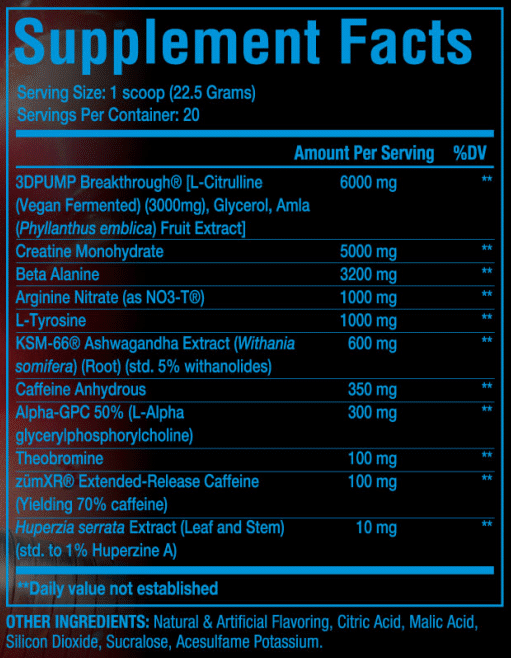
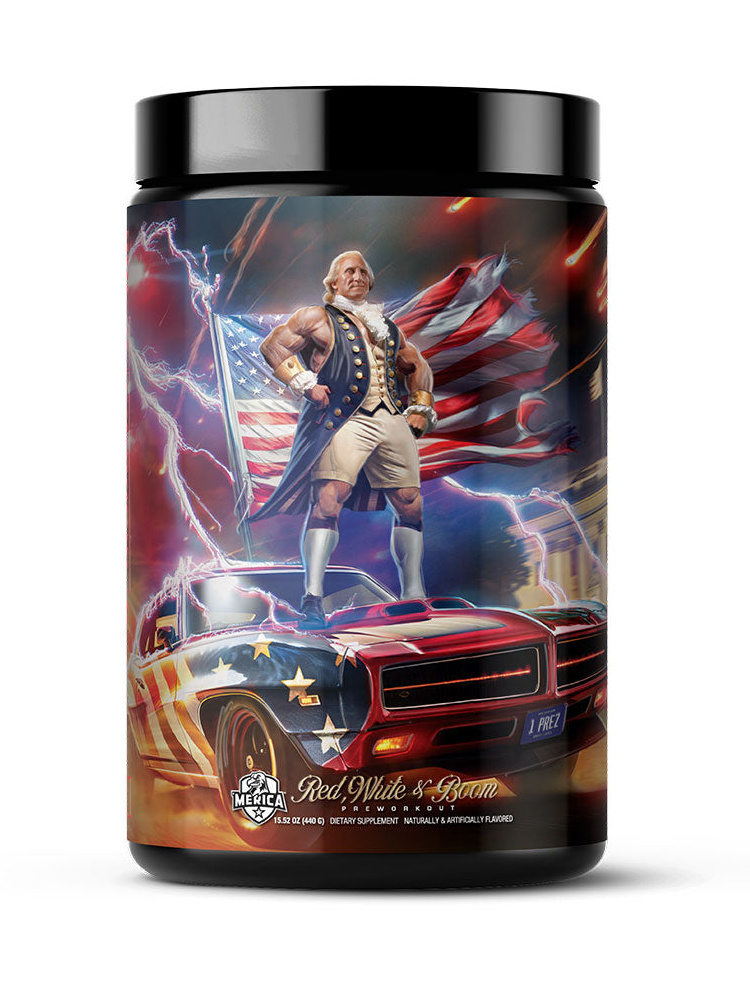
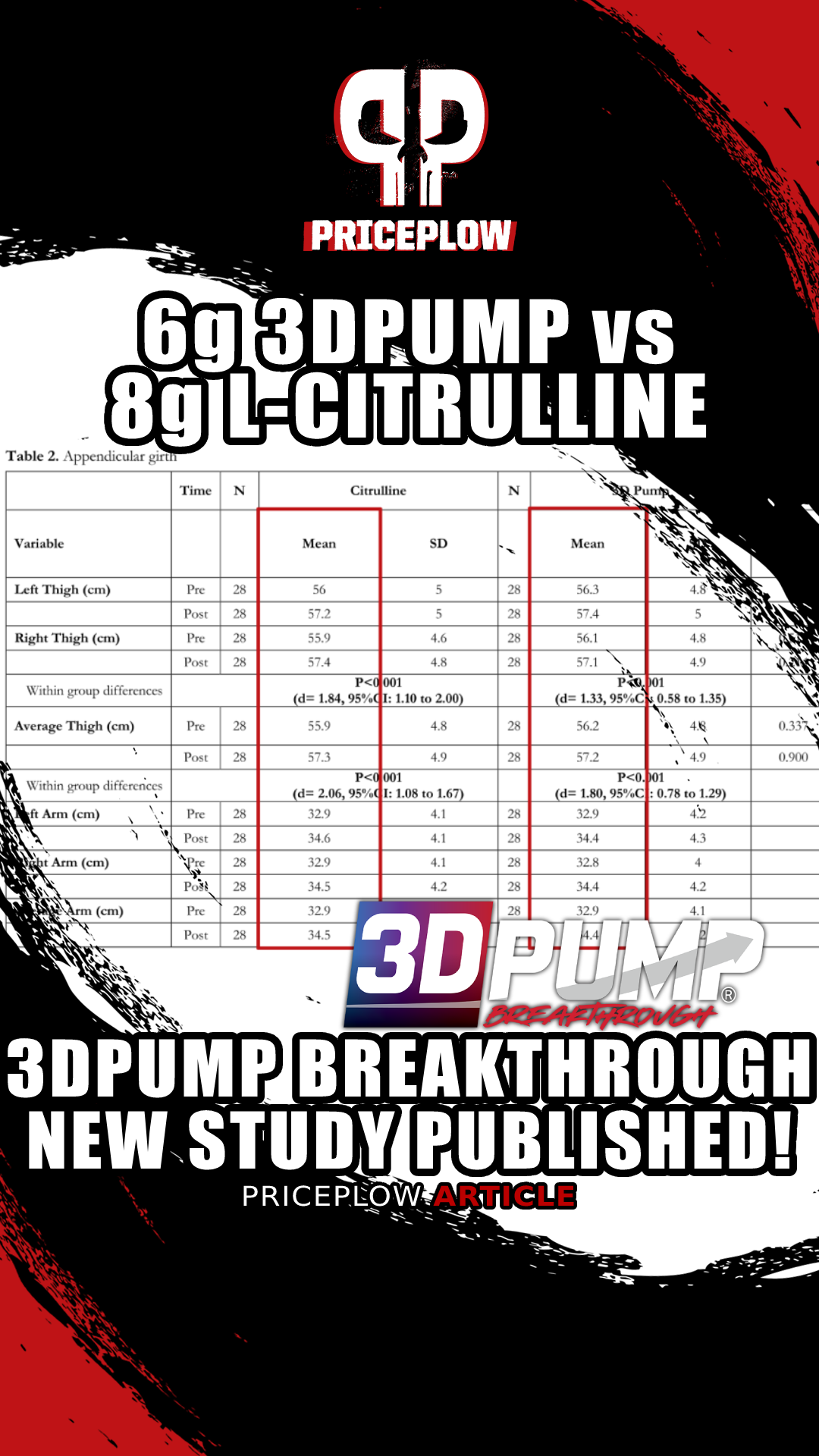

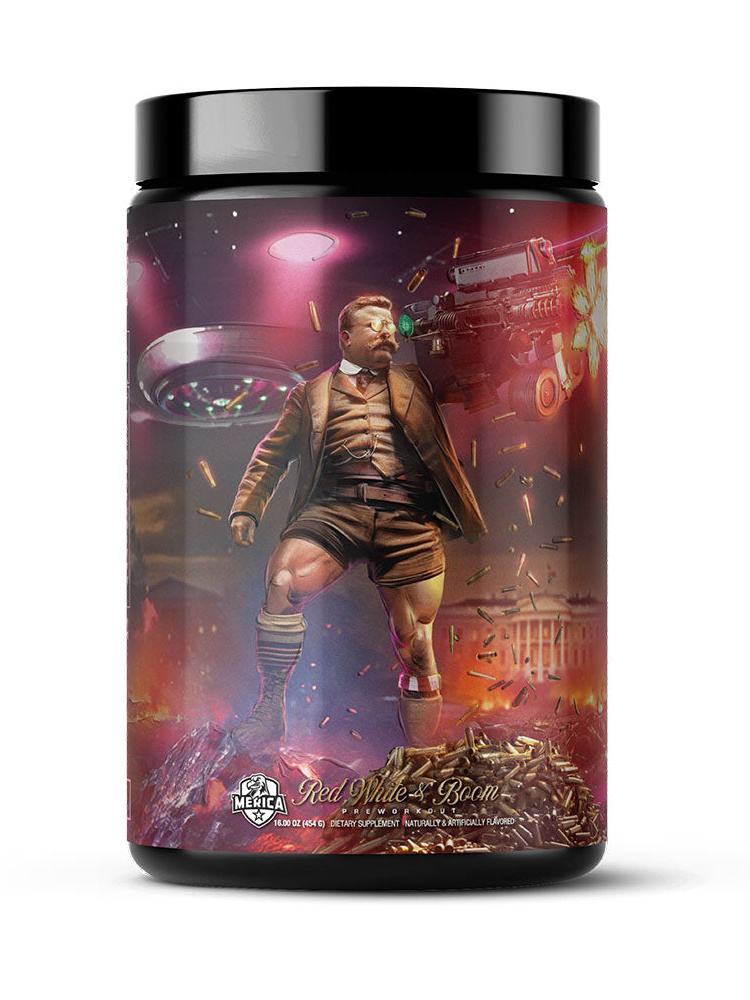
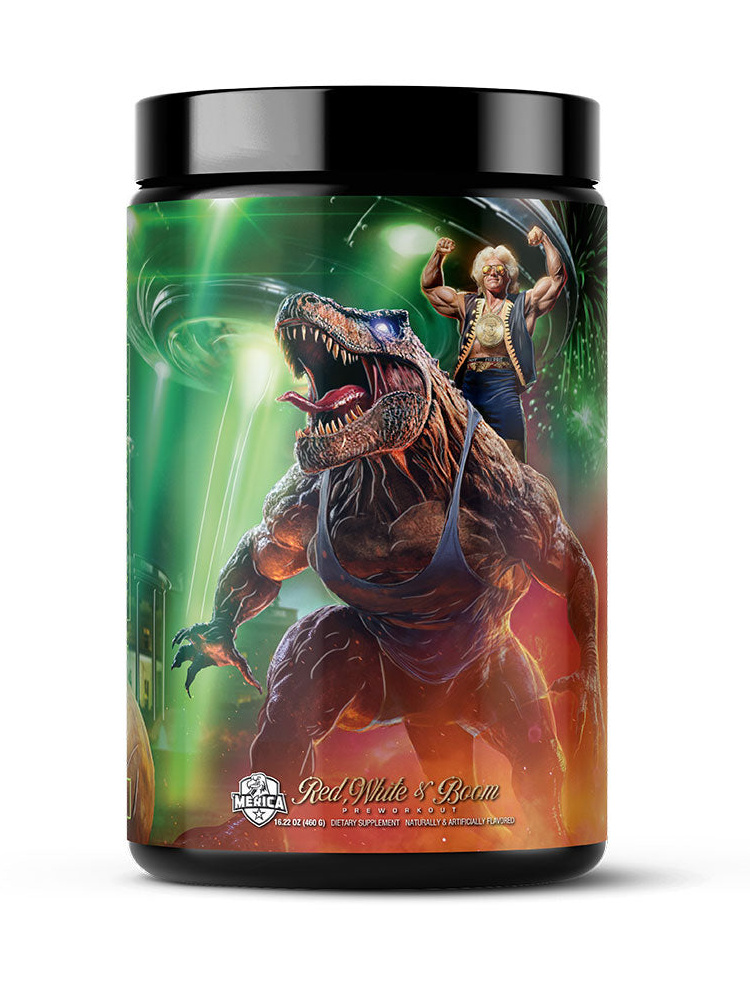
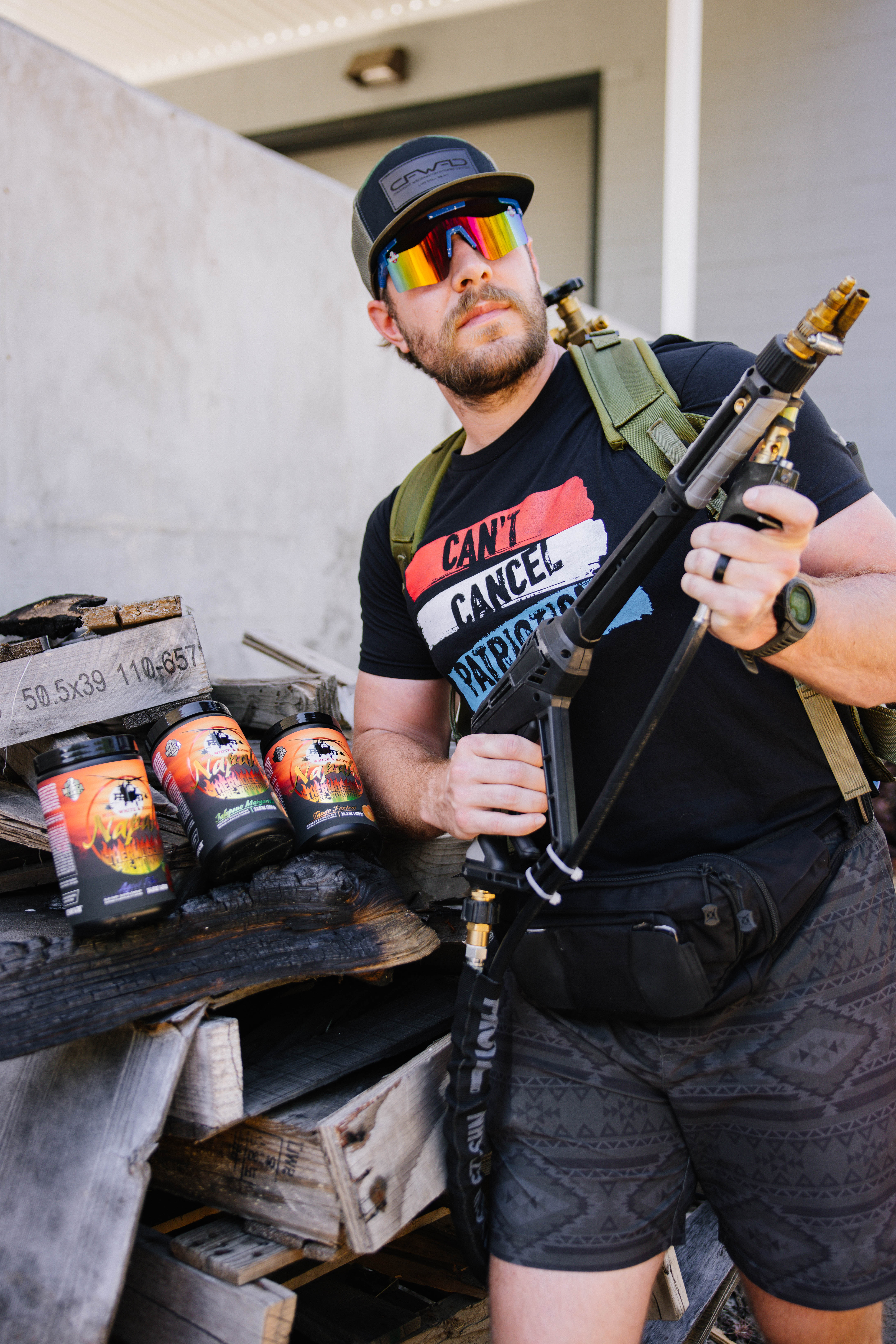

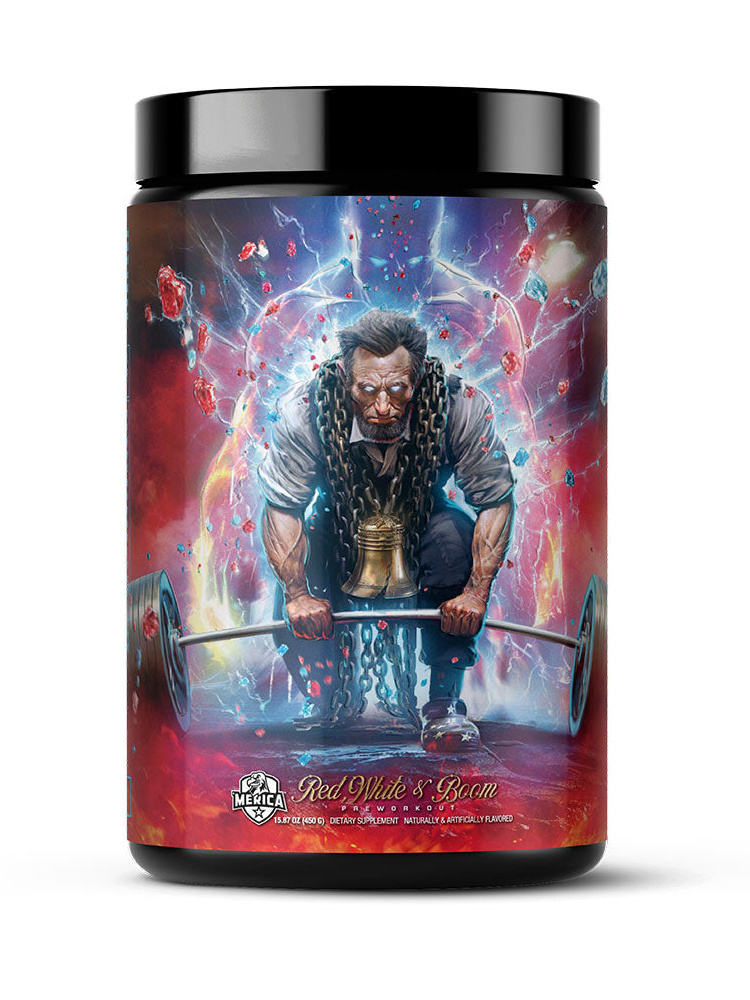


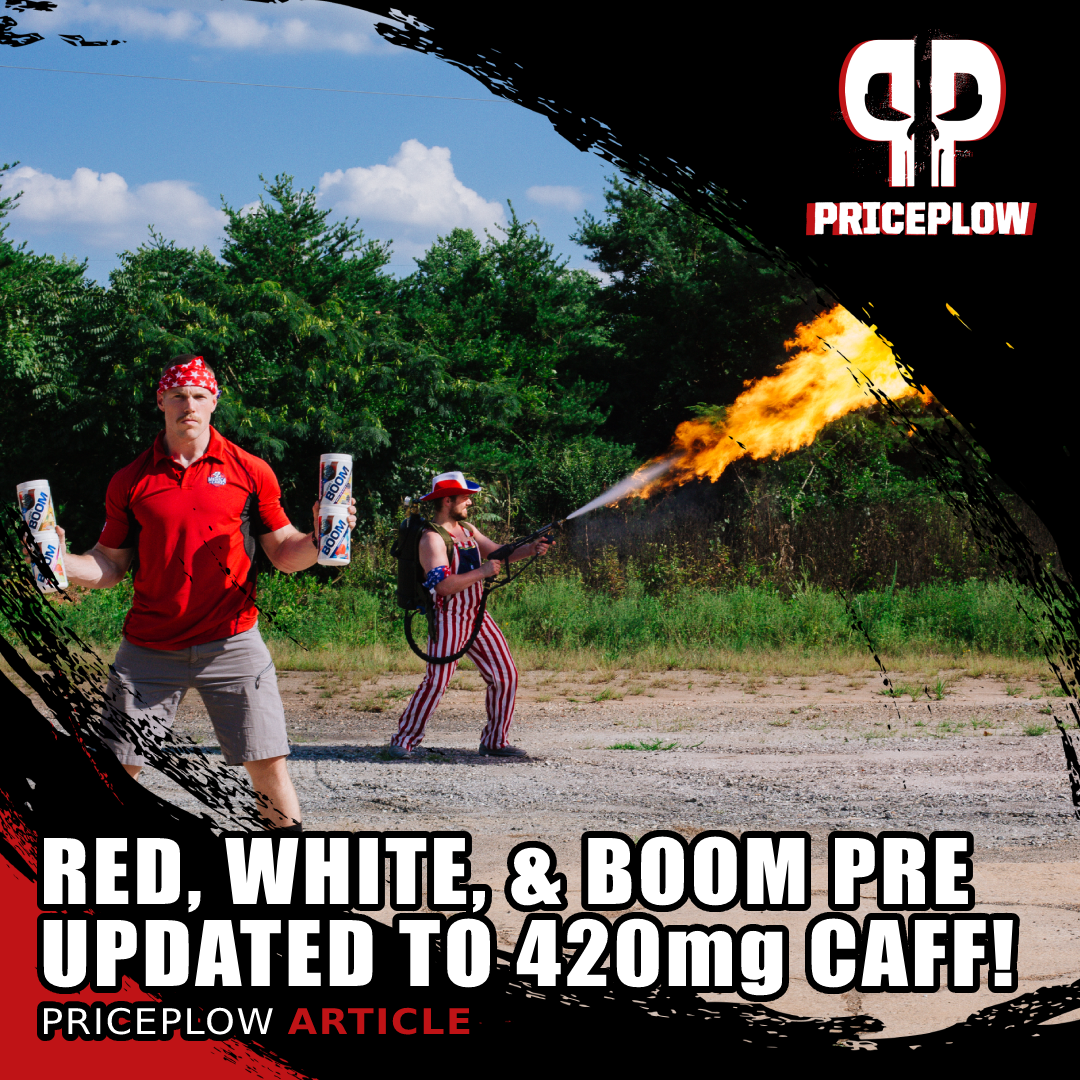
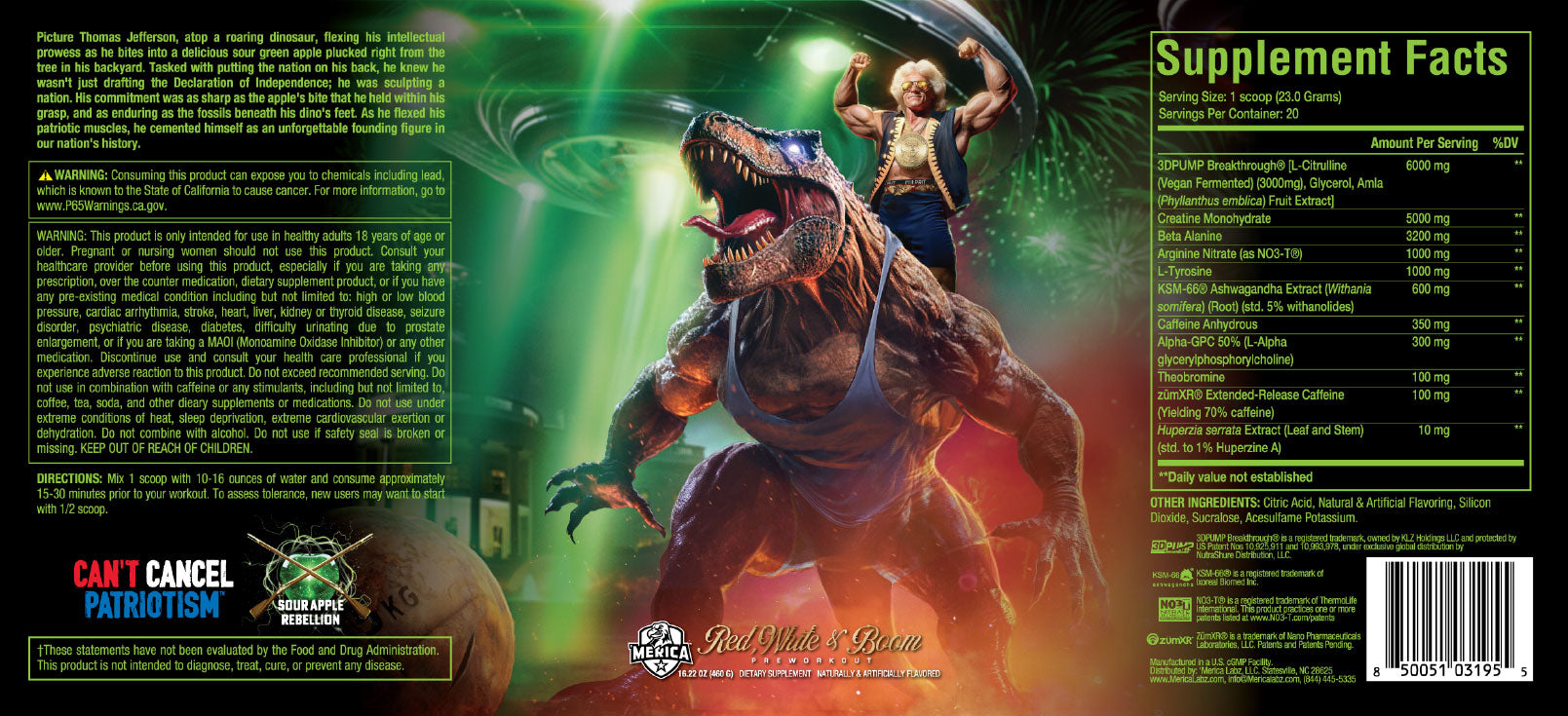

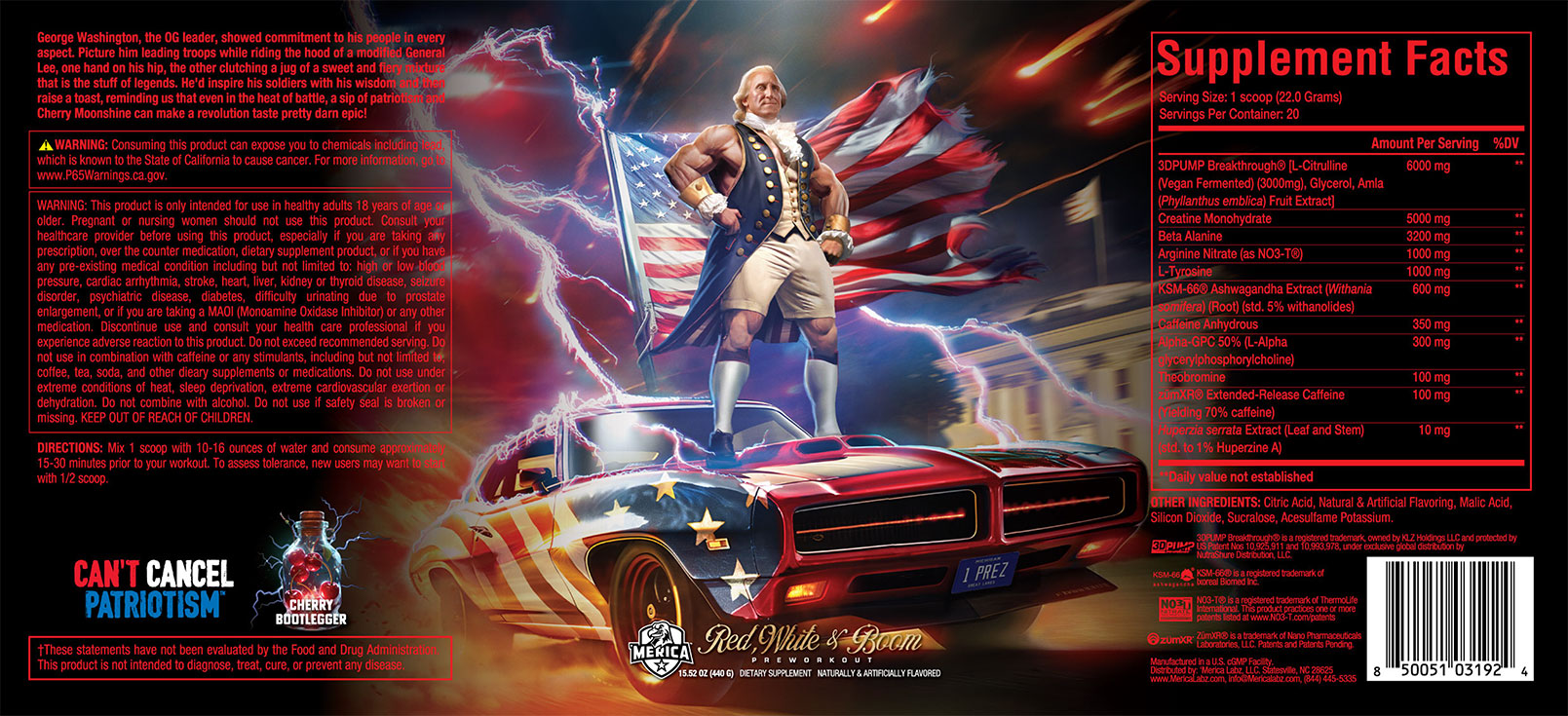
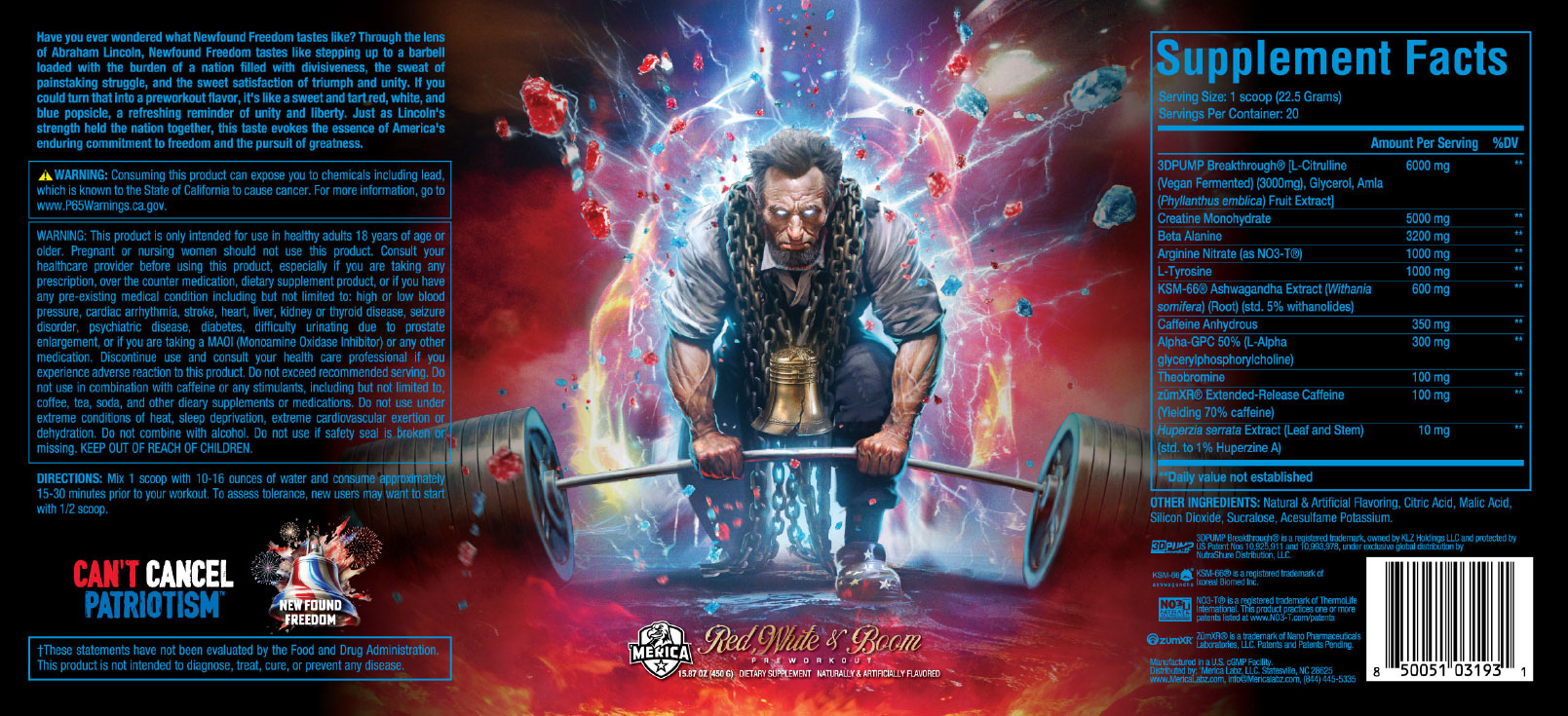


Comments and Discussion (Powered by the PricePlow Forum)